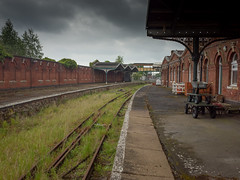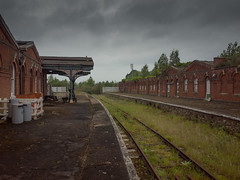The GoPro ‘Hero’ camera is an obvious choice for KAP; just pick one up and you’ll see why- it’s wonderfully light and ‘HD’ too! So for a while now we have been seeing a growing number of ‘bug-eyed’ KAP shots and for me the novelty has worn off pretty quick: so much of the detail gets ripped apart by the spherical distortion. I reckon only a third of the image is useful for anything other than to sit back and gasp at the width! Spherical projection is no big deal (there is only one variable right?) but there are a number of ways of re-projecting the image to a more ‘human’ perspective. I’m going to show here how I achieved the shunt in Adobe Lightroom by fooling it to recognise the lens properties of the GoPro lens.
 With the ‘Constrain Crop’ feature off (above) you can see how much image are you are going to loose with the correction.
With the ‘Constrain Crop’ feature off (above) you can see how much image are you are going to loose with the correction.
Here is the off camera image: It’s taken by Matt nh http://www.flickr.com/photos/68177735@N00/6719422123/ of Zoutkamp in the Netherlands and he has asked me how to De-fish it.
It’s taken by Matt nh http://www.flickr.com/photos/68177735@N00/6719422123/ of Zoutkamp in the Netherlands and he has asked me how to De-fish it.
In Lightroom the ‘Develop’ panel has a Lens correction section and there is no lens profile availabe for GoPro but from the Exif I know the focal length is given as 16mm so by scrabbling through the available profiles I plumped for a Nikkor 16mm AF fisheye- the closest thing.
and there is no lens profile availabe for GoPro but from the Exif I know the focal length is given as 16mm so by scrabbling through the available profiles I plumped for a Nikkor 16mm AF fisheye- the closest thing.
 And the applied correction looks like this:
And the applied correction looks like this: Now I can switch from ‘Profile’ to ‘Manual’ control of the lens correction:
Now I can switch from ‘Profile’ to ‘Manual’ control of the lens correction: and push the ‘Distortion’ slider (+58) to smooth the perspective a bit. Then the corrected image is exported and that’s the job done!
and push the ‘Distortion’ slider (+58) to smooth the perspective a bit. Then the corrected image is exported and that’s the job done!
There are a number of other ways discussed here and a good Hugin tutorial on this is here.
An assesment of HD GoPro Hero3 effective image area is here
Replacing the GoPro (version 1 and 2) lens with a less extreme width one is discussed here
Happy fishing!
B






LOL.
That is pretty neat.
And a fast made tutorial.
Thumbs up! 🙂
Nice. I think you could also apply the distortion in the profile mode, and then save the settings as a new profile. At least in lightroom 3.5…
Yes saving the profile is a good idea. I’d like to find out how to deal with the apalling fringe moiree effect on the GoPro too, any ideas?
About the fringes… do you mean the wide ones (tens of pixels) that are sometimes visible over the hole image? I think the are a result of re-sampling. I guess there’s something special in the way pixels are handled in the GoPro (sometimes you can see a weird sort of granularity at 100% magnification…
Anyhow I found out that they go away in Gimp when I switch the re-sampling method from cubic to something called ‘Sinc (Lancoz3)’. I’m not sure what is available in Lightroom, but you may have more luck with another sampling method…
The problem is with the image edges, there seems to be a proportional drop in sharpness as you move away from the centre of the projection- up to the point whete things get very fuzzy at the corners of the image.
I’ll have a look at the sampling options though.
B
Just received my GoPro HD2 today… at last (ordered in December for a bargain price
About the drop in sharpness: I think it is mainly caused by the fish-eye effect of the lens. A fish eye maps angles to pixels in a more or less linear way. When remapping a wide angle to a rectilinear (normal) image the same view angle corresponds to much more pixels on the image sides. In the case of the GoPro images this ‘dilution’ of the original pixels is about 5 times at the center-left and center-right. It is MUCH worse at the corners.
B.t.w. When I try to ‘correct’ the GoPro images with Hugin, choosing a 15.4 mm fish-eye lens gives good results (straight lines in the world become straight lines in the processed image)
To be continued…
I made some enquiries and hear it it should be possible to set up a radial filter to apply a ‘sharpness blur’ progressively from the centre in Lightroom 4 ( which is at beta). Another approach is to re-scale the image to compress the spreading effect after re-projection: you would lose resolution in the centre but you might get a nice consistency that way!
The 10.5mm Nikkor lens I use has the same effect too, as you say its a property of fish eyes, I use it to get economy of cover but I’m beginning to wonder if its worth it as the stitching is horrible.
Enjoy the new camera Hans, I love your marine shots…and let me know how you get on.
B
I tried to stitch corrected (and uncorrected) gopro photo’s taken of seagras fields, but for that it is not the best tool. Back to my trusted S95 for that, with all the “lost at sea” risks…
Stitching corrected fisheye stuff is like playing billiards with elliptical balls! I can just about get it to work with the Nikkor 10.5 lens, presumably because the correction for it in Lightroom is fairly precise but even so I had to use a very deep overlap. I think there is some economy in using the ‘ultra wide’ lenses simply because of the better field of view at restricted height- but its still a case of ‘shoot many and use few’ for me!
Yes, I was able to make adequate stitches from images taken from 1 point, but a series of ortho pictures made when moving, for mapping, gave to much headache, even I had hugin do the corrections. Trying the corrected images in Qgis also warped the images too much.
I played a bit more with Hugin to see how well it rectifies GoPro images… not bad at all!
Hans,
Have you been able to get Hugin to report the focal length, (principle point and sensor size would be nice too but I’d be surprised if it did!) PT Gui (which I think is the same as Hugin?) only works with the Exif reported ‘f’. It would be grat to get a better value.
Have you been able to stitch any of the GoPro images into a mosaic as Jasja heas tried?
B
Bill,
I have stitched only a few experimental (GoPro) pano’s with Hugin (which is not the same as PTGui). I feed it the uncorrected images, use the exif focal distance (16mm) and select spherical fish-eye lens. The last step is very important. The results are quite good if ther is not too much translation between the images. A large overlap helps a lot. I us Hugin mostly to correct geometric distortion in single images, which works great!
I tried to add images in my previous post, but that didn’t work. They are here:
http://www.flickr.com/photos/hanselpedia/6852974709/
PS: when processing images with a large overlap Hugin can be used to compute improved lens parameters (which minimize the re-projection error, you can select this in the optimizer tab).
I wish I had (much) more time to play with all this but there is work to be done and kites to be flown 🙂
Hans,
That works really well! I think the mosaic problem is best sorted by using a deep overlap from a common centre. Edge to edge matching is never going to be easy when you see how ‘stretched’ the edges get.
I have found your comment on the KAP discussion board and your ‘best’ value for the focal length for your GoPro HD2 of 15.6mm for a circular fish eye correction in Hugin suggests getting a good f value is key to good results and the manufacturers quoted 16mm is a bit wide of the mark!
I’d like to see what the lens parameters are for the focal length from a good set of convergent shots, I susepect that these very ‘short’ values are sensitive to refinement.
I love your Kinderdjyk series…but I’d love to see more true nadir shots 😉
Fly on man!
Pingback: De-fish een foto, gemaakt met Samyang lens?
Pingback: Aerial Photography in Buena Vista | digital. stories. by Patrick Brown
That was very helpful, thanks!
Pingback: So, what to do with that old GoPro?… | Billboyheritagesurvey's Blog